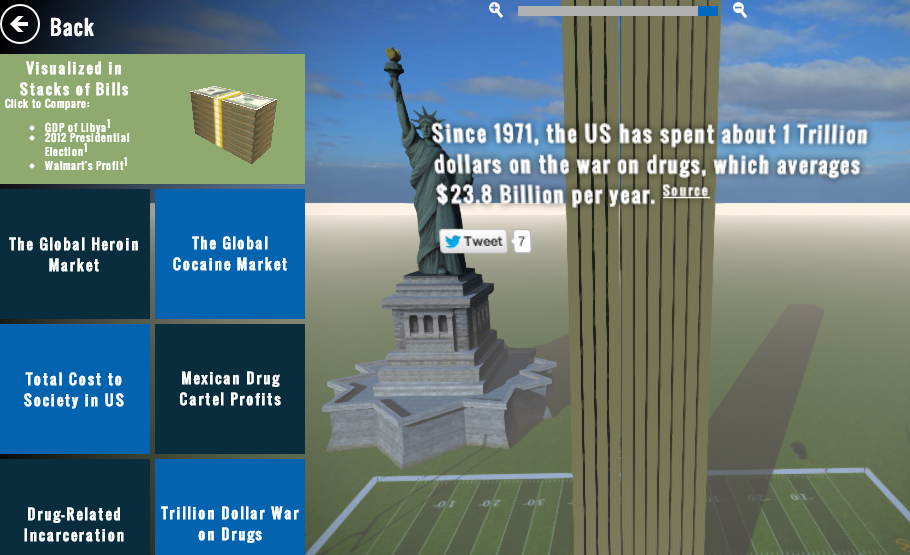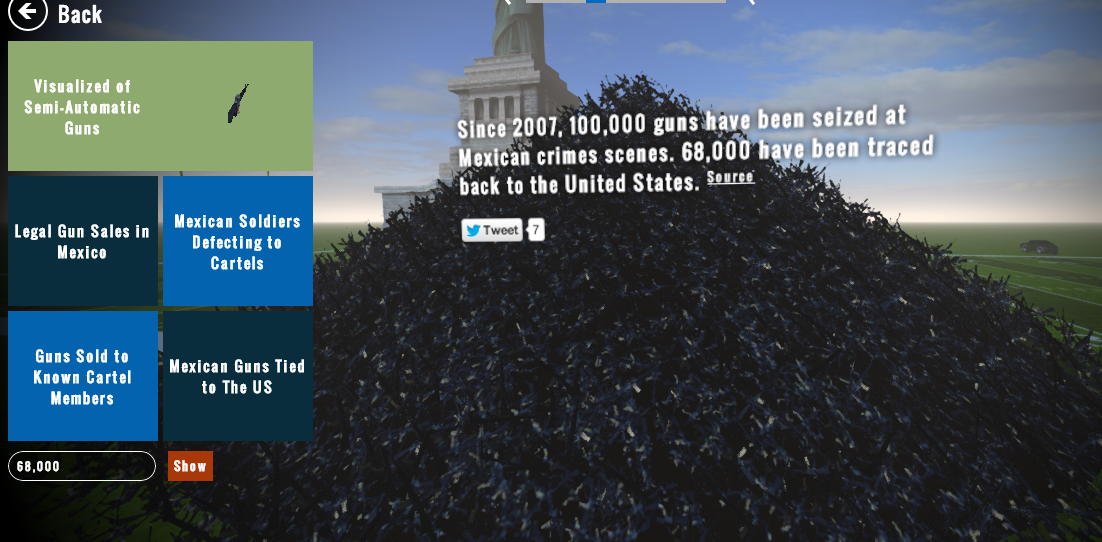
What is the true cost of illegal drugs to society?
The U.S. has spent $1 trillion on the War on Drugs since 1971, yet the current global market for heroin exceeds $55 billion and the market for cocaine consumes about $88 billion annually. The National Institute on Drug Abuse, a governmental organization that uses scientific research to investigate the causes of drug addiction, estimates that the U.S. loses $181 billion each year to the associated crime, health care costs and lost work hours due to illegal drug abuse.
Admittedly, it is hard to grasp the image of a $1 trillion drug war, or the 181 tons of cocaine, or hundreds of thousands of guns, to understand the scale of the problem. So, for some sobering comparisons, Rehabs.com created an interactive WebGL project "The Economy of the War on Drugs," which allows you to see the true scale of America's illegal drug consumption.

Deaths Are Multiplying
Internationally, the effects of the America's illegal drug consumption are felt deeply. In Mexico, up to $29 billion spent by Americans on illegal drugs goes straight into the pocket of drug cartels. The violence surrounding the cartels and the Mexican government's prosecution of the cartels has been completely devastating to the country. Since 2006, there has been ruthless acts of backlash at those trying to thwart the problem, with 3,000 Mexican soldiers killed and at least 20 mayors have been assassinated as a result of the war on the drug cartels. Beheadings, kidnappings, massacres of citizens and attacks on journalists have become commonplace as the cartels have grown and splintered into various factions as a result of the crackdown led by the Mexican government.

Guns Kill People
Adding to the problem, it is reported that many American guns have been steadily making their way south, bolstering the cartels firepower. Of the 100,000 guns seized at Mexican crime scenes since 2007, more than 68,000 of them were traced back to the U.S. Many of Mexico's guns are actually coming straight from the U.S. through legal channels. Through a process called "direct commercial sales," a foreign government can request to buy guns from private sellers in the U.S. by submitting a form to the State Department. In 2009, the State Department estimated a quarter of the guns they allowed to be sold to Mexico were diverted to the cartels. Since then, the State Department has stopped disclosing the numbers of guns sold to Mexico. (When asked, they refused to give CBS estimates in both 2010 and 2011.)

Its not just U.S. guns killing citizens in Mexico, it has also been reported that many Mexican soldiers -- with their rifles and firearms -- have defected to the cartels as well, and it is estimated that at least 150,000 soldiers have already chosen the wrong path.
What does all this mean for South and Central America? Demand for illegal drugs is high. As much as 90 percent of the cocaine consumed by Americans is produced in South America and sold by Mexican cartels. In 2010, the average number of drug-related deaths in Mexico was 41 per day.
What about the effects of Illegal Drugs on the U.S.? There has been an average of 826 drug-related deaths in Los Angeles County annually between 2000 and 2009, and the average monthly number of drug-related deaths across the entire U.S. was 3,123 in 2009 which is still less than nine per day, far less than Mexico's 41 per day. For the first time ever, drugs are killing more people than automobiles.
What has the worst effect on the economy? Cocaine and heroin.
Up to 450 tons of heroin are produced and sold annually, and around 24 tons of that is consumed in the U.S. and Canada each year. In addition to the heroin problem, an estimated 953 tons of cocaine were produced in 2008, and the U.S. alone consumes almost 20 percent of that annually. In fact, the United States is the world's largest drug consumer.
So what is the true cost of illegal drug use and the War on Drugs?
Americans are incarcerated for drug-related charges, costing the U.S. $400 every second, $1 billion a month, or $12.6 billion a year.
U.S. consumption of illegal drugs creates a steady demand for substances like cocaine and heroin, which are produced in many very poor areas with little governmental control, which increases lawlessness and leads to the premature deaths of millions every decade.
At home, besides the thousands of deaths reported due to drug usage each year, the U.S. spends billions incarcerating Americans for drug-related crimes. There's no concrete way to accurately tally all of this sadness and heartache up; in terms of lives lost, dollars wasted and addictions created, the effects have been truly devastating. If we start to make changes at home today that address the problem in our communities, maybe in a decade or two the lives of the people in Mexico, Central and South America and Afghanistan could greatly be improved.